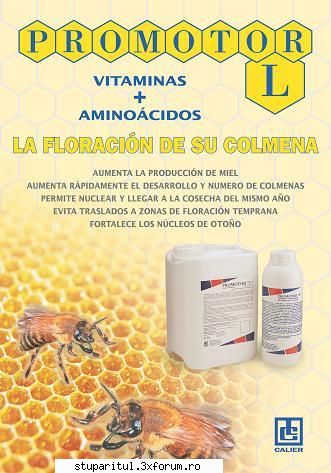skypi_0040
apicultor
 Din: Resita
Inregistrat: acum 16 ani
Postari: 256
|
|
Am primit instructiunile dar sunt inca in limba engleza.
Am sa le postez pentru cei ce le au cu limbile iar ceilalti sa astepte pana le traduc.
INSTRUCTIONS FOR THE USE OF AMINOVITASOL IN APICULTURE
1 - HOW TO DIVIDE AND HOW TO NUCLEATE BEEHIVES AT THE END OF THE SEASON
DIVISION:
After finalising the harvest we find a beehive composed to 10 movable frames, most of them with honey, pollen and a great number of bees.
At this moment it is advisable to proceed with the division of the beehives in order to later feed them so that they can survive the winter season.
Elements that should be available when carrying out the division:
1 deep riser or large riser
1 bottom board
1 roof
2 Doolite frame feeders with floater
1 queen excluder
fertilised queen bee or queen cells
2 foundation wax
First the mother hive is uncovered, and one of the side frames is removed. The bees are shaken off and we place it in the other hive body, the future breeding chamber or new beehive. We continue to remove up to the fifth frame repeating the same procedure.
In both the mother beehive and the new beehive we place a foundation wax and the feeder.
A queen excluder is placed in the mother beehive and on top of this a new division, making sure that the upper frames coincide with the lower frames.
This is covered and after 5 hours we can observe that the bees are already distributed according to the needs of each division.
At this moment we can make a determined division by removing the upper hive, with the roof included, and resting it on the floor. The hive entrance should be covered with foam rubber, in this way being in adequate conditions for being moved to a distance of at least 2 kms away in order to avoid the return of the collector bees.
The next day the fertilised queen bee is introduced by any of the indirect introduction methods or by the direct method with ammonium nitrate.
ALIMENTATION:
The feeder should be filled with sugar syrup and AMINOVITASOL:
Preparation of the syrup: 6 litres of water + 10 Kg of sugar.
Dosage of AMINOVITASOL: 4 millilitres per litre of syrup.
On the four day we return to the apiary and top up the level of syrup in the feeder in the same proportion as already described. We should observe if the foundation wax has been built, if so, we place a new one in the middle of the breeding nest. If the wax is not built, wait until the next alimentation before introducing another. The alimentation should be repeated every 7 days until completing the 9 frames in the beehive.
IMPORTANT RECOMMENDATIONS:
- Do not introduce a new foundation wax until the previous one has been built.
- In the case that queen cells are used, or a natural system (blind nucleus), only feed with syrup, without AMINOVITASOL, until the queen bee has been fertilised and starts to lay eggs.
- Make an analysis for Nosema and in the case of being positive, apply the adequate treatments.
- Cure against European Foulbrood with antibiotics of known brands.
ALTERNATIVES TO BE FOLLOWED:
- After obtaining the 9 frames, a maintenance treatment should be carried out with the same sugar syrup without AMINOVITASOL, prepared in a proportion of 1 litre of water for each 2 kgs of sugar for up to 60-70 days before the flowering period, the moment at which the STIMULATION will start (see below). The syrup should be replaced in the feeder every 20 days.
- Another option is that when arriving at 5-6 frames, and you do not wish to continue up to 9, continue the alimentation with syrup only, without AMINOVITASOL, every 20 days until the start of the motivation.
- Move the beehives to early flowering areas for harvest.
- Make nuclei without moving the beehives using fertilised queen bees from queen banks or imported queens.
2- STIMULATION OF BEEHIVES 60-70 DIAS BEFORE THE MAIN FLOWERING PERIOD
PREPARATION OF SUGAR SYRUP FOR STIMULATION:
SYRUP OPTIONS
Type a.- SUGAR - WATER
Type b.- LEVUDEX 42 and/or LEVUDEX 55
Syrup Type a.- Preparation: heat tap water up to approximately 75 ºC to 80 ºC, remove from the heat and start to add the sugar, stirring constantly up to total dissolution of the sugar grains. The syrup should be left to stand until it reaches room temperature before being used. The syrup will be prepared with 6 litres of water and 10 kg of sugar.
The syrup can also be prepared with cold water, making sure that all the sugar is well dissolved and should be prepared at least three or four hours before being administered.
Add PROMOTOR “L” to the syrup according to the indicated specification.
It is recommended to verify in each feeding that the syrup + AMINOVITASOL is not fermented. If it is in this condition it should be discarded.
Syrup Type b. - this is a commercial line of CORN PRODUCTS, and it is not necessary to add anything whatsoever, or to dilute it or to heat it – it is used at room temperature.
Add PROMOTOR “L” to the syrup according to the indicated specification.
Note: If left without AMINOVITASOL, continue feeding with only sugar syrup until obtaining more.
HANDLING OF THE BREEDING CHAMBER: start of the process
PREPARATION OF THE BEEHIVE OR NUCLEUS: Fix DAY-MONTH
DAY 1: Open the beehive and remove the frames that contain honey and pollen.
Only leave those frames with young of those that are covered with bees, add a frame feeder (Doolite). The frames should be against the wall and the feeder towards the centre full of syrup with AMINOVITASOL.
Why leave only the frames with young or those covered with bees?
Our main objective is to induce the bees to build the foundation wax and to favour the egg-laying of the queen bee. If all the frames were available, they would dedicate their time storing the syrup in the cells and the expected results would not be obtained.
DOSAGE: 7 millilitres of AMINOVITASOL per litre of syrup.
DAY 4
Add a frame of foundation wax between the feeder and the last frame. Replace the medicated syrup that has been consumed.
DOSAGE: 7 millilitres of AMINOVITASOL per litre of syrup
1st WEEK (Day 11 from the start). Verification and observation
DOSAGE: 7 millilitres of AMINOVITASOL per litre of syrup
Replace the syrup + AMINOVITASOL that has been consumed
• If in the foundation wax placed earlier the bees have accumulated syrup, remove the frame and place it far away from the beehives so that the bees collect the syrup (looting). Add another frame of foundation wax in the middle of the breeding nest.
• If the frame with foundation wax has been worked on and the queen been has laid eggs, add another frame with foundation wax in the middle of the breeding nest.
2nd WEEK (Day 17 from the start). Verification and observation.
DOSAGE: 5 millilitres of AMINOVITASOL per litre of syrup.
Replace the syrup + AMINOVITASOL that has been consumed.
Place a frame with foundation wax in the middle of the breeding chamber.
3rd WEEK - (Day 24 from the start) Verification and observation.
DOSAGE: 5 millilitres of AMINOVITASOL per litre of syrup.
Replace the syrup + AMINOVITASOL that has been consumed.
Control that the medicated syrup is not fermented. To the contrary, discard the syrup and replace it with fresh product.
Place a frame with foundation wax in the middle of the breeding chamber if the larvae are affected by Melissococcus pluton. Make the corresponding cures.
4th WEEK – (Day 31 from the start) Verification and observation.
DOSAGE: 4 millilitres of AMINOVITASOL per litre of syrup.
Replace the syrup + AMINOVITASOL that has been consumed.
Place a frame with foundation wax in the middle of the breeding chamber.
5th WEEK – (Day 38 from the start) Verification and observation.
DOSAGE: 4 millilitres of AMINOVITASOL per litre of syrup.
Replace the syrup + AMINOVITASOL that has been consumed.
Place a frame with foundation wax in the middle of the breeding chamber.
Make analysis for Nosema and carry out treatment if this should be necessary. Control the varroa.
Observe if there is any frame with stored syrup and, if so, remove it.
6th WEEK – (Day 45 from the start) Verification and observation.
DOSAGE: 4 millilitres of AMINOVITASOL per litre of syrup.
Replace the syrup + AMINOVITASOL that has been consumed.
Place a frame with foundation wax in the middle of the breeding chamber; many of your beehives will surely be able to built 2 frames with foundation wax per week as from this moment.
7th WEEK – (Day 52 from the start). Verification and observation.
DOSAGE: 4 millilitres of AMINOVITASOL per litre of syrup.
Replace the syrup + AMINOVITASOL that has been consumed.
Place two frames with foundation wax in the middle of the breeding chamber, intercalated by 2 breeding frames.
Repeat the analysis for Nosema and verify the existence of Melissococcus pluton.
8th WEEK – (Day 59 from the start). Verification and observation .
DOSAGE: 4 millilitres of AMINOVITASOL per litre of syrup.
At this moment most of the beehives will have 9 broodcomb frames and with many bees. Attention must be paid to AVOID THE COLONISATION OF THE BEEHIVE, for which it is important to give plenty of room by removing broodcomb frames which can be used for reinforcing other, weaker beehives.
ALTERNATIVES TO BE FOLLOWED from day 66 from the start:
1. HARVEST: If at this moment you have flowering of 5 - 10 % available, remove the feeder and place a foundation wax in the middle of the breeding chamber. Place a half-super or a super and then harvest. If the flowering period is delayed according to what you have planned, continue to feed giving sufficient room so that colonisation does not take place.
2. NUCLEI OR DIVISION: This can only be done if you have fertilised queens or queen cells available. If you make blind nuclei or with queen cells, DO NOT FEED WITH AMINOVITASOL; feed with sugar syrup only until the queen starts laying eggs.
AMINOVITASOL DOES NOT CONTAIN ANABOLIC HORMONES; it only contains amino acids and vitamins.
Keep AMINOVITASOL in its original container.
_______________________________________
Fii bun, dar fereste-te sa nu creada lumea ca poti fi numai bun.
|
|

 .Am si compozitia, poate va intereseaza.
.Am si compozitia, poate va intereseaza.




